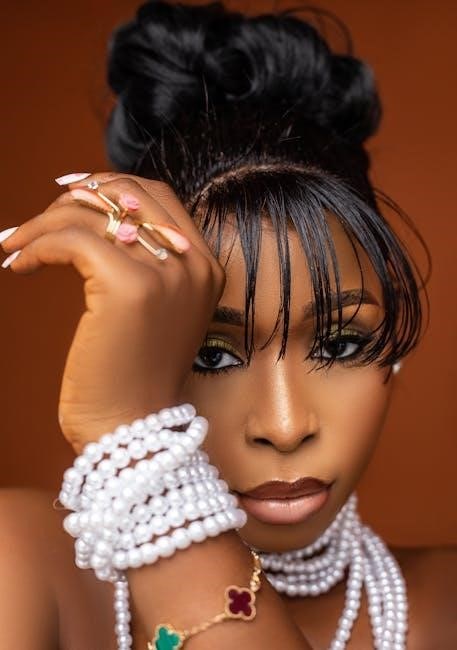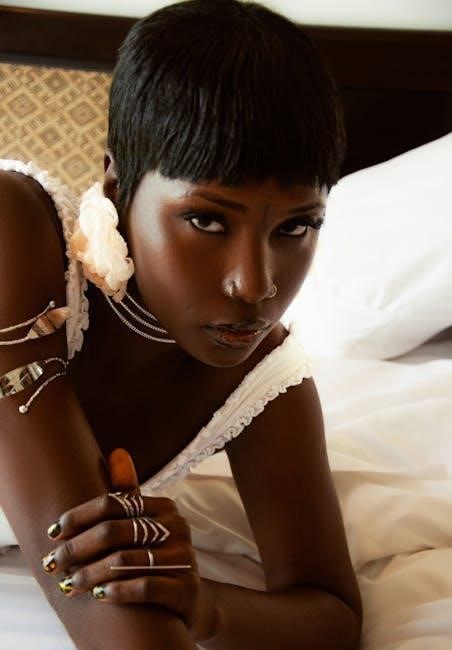Embark on a journey through Middle-earth with this essential Lord of the Rings movie guide. Discover the trilogy’s epic story, stunning visuals, and behind-the-scenes insights for fans and newcomers alike.
Overview of the Lord of the Rings Film Trilogy
The Lord of the Rings film trilogy, directed by Peter Jackson, is an epic adaptation of J.R.R. Tolkien’s classic novel. Comprising The Fellowship of the Ring (2001), The Two Towers (2002), and The Return of the King (2003), the series follows Frodo Baggins’ perilous journey to destroy the One Ring. With stunning visuals, intricate world-building, and unforgettable characters, the trilogy has become a landmark in cinema. Its rich storytelling, emotional depth, and groundbreaking special effects captivated audiences worldwide, solidifying its place as a cultural and cinematic phenomenon.
Why the Lord of the Rings Movies Are a Cultural Phenomenon
The Lord of the Rings movies have transcended cinema to become a cultural phenomenon, resonating with audiences globally. Their intricate world-building, memorable characters, and universal themes of friendship and sacrifice have inspired countless fans. The trilogy’s influence extends beyond film, shaping literature, art, and even video games. Its success lies in blending stunning visuals with emotional storytelling, creating a shared experience that unites viewers worldwide. The films’ impact on popular culture is undeniable, making them a timeless epic that continues to captivate new generations.

The Lord of the Rings Trilogy
Directed by Peter Jackson, this epic fantasy trilogy brings J.R.R. Tolkien’s novels to life, captivating audiences with its rich storytelling and cinematic grandeur.
The Fellowship of the Ring (2001)
The Fellowship of the Ring, directed by Peter Jackson, sets the stage for the epic trilogy. The film follows Frodo Baggins (Elijah Wood) as he inherits the One Ring and embarks on a perilous journey to destroy it in Mordor. Joined by a diverse fellowship, including Gandalf (Ian McKellen), Aragorn (Viggo Mortensen), and others, the group faces treacherous landscapes and formidable foes. Iconic scenes like the Council of Elrond and the Mines of Moria captivate audiences, blending stunning visuals with emotional depth; This film laid the foundation for the trilogy’s success, earning critical acclaim and setting the tone for the adventures to come.
The Two Towers (2002)
The Two Towers, the second installment of the trilogy, sees the fellowship divided and the stakes heightened. Frodo (Elijah Wood) and Sam (Sean Astin) continue their perilous journey to Mordor, navigating the treacherous Gollum (Andy Serkis), whose internal conflict adds depth to the story. Meanwhile, Aragorn (Viggo Mortensen), Legolas (Orlando Bloom), and Gimli (John Rhys-Davies) form an unlikely alliance to rescue Merry and Pippin from the clutches of Sauron’s forces. The film culminates in the epic Battle of Helm’s Deep, showcasing breathtaking visuals and intense action. Peter Jackson’s masterful direction weaves these parallel narratives seamlessly, setting the stage for the trilogy’s climactic conclusion.
The Return of the King (2003)
The Return of the King is the triumphant conclusion to Peter Jackson’s trilogy. Frodo (Elijah Wood) and Sam (Sean Astin) face their greatest challenges as they near Mount Doom, while Aragorn (Viggo Mortensen) embraces his destiny as King of Gondor. The film’s climax features the epic Battle of the Pelennor Fields and the destruction of the One Ring. The Return of the King won 11 Academy Awards, including Best Picture and Best Director, cementing its legacy as a cinematic masterpiece. Its emotional depth, stunning visuals, and faithful adaptation of Tolkien’s novel make it a timeless classic in fantasy cinema.
Extended Editions of the Trilogy
The extended editions of The Lord of the Rings trilogy offer a richer cinematic experience, featuring additional scenes, extended battles, and deeper character development. These versions provide fans with a more immersive journey into Middle-earth, showcasing Peter Jackson’s vision in its entirety. The extended cuts include moments like the Battle of Helm’s Deep’s aftermath and Faramir’s initial encounter with Frodo, adding layers to the story and characters.
Available in 4K Ultra HD, these editions are a must-have for collectors, offering enhanced visuals and sound. They also include behind-the-scenes content, making them a treasure trove for fans seeking a comprehensive understanding of the trilogy’s creation and legacy.

The Hobbit Trilogy
The Hobbit Trilogy enriches Middle-earth’s lore, introducing Bilbo Baggins and expanding on familiar characters. While praised for visuals, it sparked debate on pacing and narrative expansion.
An Unexpected Journey (2012)
The Hobbit: An Unexpected Journey marks the start of Bilbo Baggins’ adventure, directed by Peter Jackson. This film introduces audiences to a younger Middle-earth, rich in lore and stunning visuals. The movie follows Bilbo as he joins a company of dwarves on a quest to reclaim their homeland, encountering trolls, goblins, and the enigmatic Gollum. The film’s use of 3D and 48fps technology was groundbreaking, though divisive among fans. It sets the stage for the trilogy, blending humor and action while expanding the world of The Lord of the Rings. Critics praised its visual spectacle and faithful adaptation, though some noted pacing issues.
The Desolation of Smaug (2013)
The Hobbit: The Desolation of Smaug continues Bilbo Baggins’ perilous journey with the dwarves. Directed by Peter Jackson, the film introduces iconic locations like Lake-town and the Lonely Mountain. The dragon Smaug, voiced by Benedict Cumberbatch, steals the spotlight with his menacing presence and clever dialogue. The film amplifies the action, featuring thrilling sequences such as the barrels escape and the climactic confrontation with Smaug. Bilbo’s character deepens as he grapples with the Ring’s influence. While praised for its visual grandeur and pacing, some critics noted its darker tone and deviations from the book. The film sets the stage for the trilogy’s epic conclusion, leaving audiences eagerly anticipating the final showdown.
The Battle of the Five Armies (2014)
The Hobbit: The Battle of the Five Armies concludes the trilogy with an epic showdown. Directed by Peter Jackson, the film centers on the conflict over the Lonely Mountain’s treasure, drawing in dwarves, elves, humans, orcs, and eagles. The film features breathtaking visuals and intense action sequences, particularly the climactic battle. Richard Armitage shines as Thorin Oakenshield, grappling with his destiny, while Martin Freeman’s Bilbo Baggins remains the emotional core. The movie ties up loose ends, bridging the gap to The Lord of the Rings trilogy. Critics praised its spectacle, though some noted its fast pacing and emotional depth. It’s a fitting finale to the Hobbit saga, leaving a lasting impact on Middle-earth’s cinematic legacy.
Behind-the-Scenes and Making-of

Dive into the creation of Middle-earth with exclusive insights into Peter Jackson’s vision, casting, production design, and filming locations that brought J.R.R. Tolkien’s world to life.
Director Peter Jackson’s Vision
Peter Jackson’s vision for the Lord of the Rings trilogy was a groundbreaking achievement, blending cinematic grandeur with faithful adaptation of J.R.R. Tolkien’s epic novel. His meticulous attention to detail and passion for Middle-earth’s lore ensured the films captured the essence of the source material. Jackson’s creative decisions, from casting to location scouting, shaped the trilogy’s identity. His use of New Zealand’s diverse landscapes brought Middle-earth to life, while his ability to balance epic battles with emotional depth resonated with audiences worldwide. Jackson’s vision not only redefined fantasy cinema but also set a new standard for cinematic storytelling, leaving an indelible mark on the film industry.
The Casting Process and Key Actors
The casting process for the Lord of the Rings trilogy was meticulous, ensuring actors embodied their characters’ depth and complexity. Key actors like Elijah Wood, Viggo Mortensen, and Ian McKellen brought iconic roles to life. Orlando Bloom as Legolas and Sean Astin as Samwise Gamgee delivered memorable performances. Billy Boyd and Dominic Monaghan shone as Pippin and Merry, while Andy Serkis’s portrayal of Gollum set a new standard for motion capture. The ensemble cast’s chemistry and dedication were pivotal in making the trilogy unforgettable, leaving a lasting legacy in cinematic history and cementing their roles as cultural icons forever. Their performances remain central to the films’ enduring success and timeless appeal.
Production Design and Filming Locations
The Lord of the Rings trilogy’s production design and filming locations were integral to its success. New Zealand’s diverse landscapes served as Middle-earth, with regions like Queenstown, Wellington, and Rotorua transforming into iconic settings such as Rivendell, Mordor, and Hobbiton. The production team, led by Alan Lee and John Howe, crafted intricate sets and costumes that immersed audiences in J.R.R. Tolkien’s world. From the towering Misty Mountains to the lush Shire, every location was meticulously chosen to bring authenticity to the story. The fusion of natural beauty and artistic vision created a visually stunning experience, making Middle-earth feel alive and forever etched in cinematic history.

Best Movie Moments and Scenes
Experience the magic of Middle-earth through unforgettable scenes like the Council of Elrond, the Balrog battle, and Gollum’s emotional “My Precious” moments, etched in cinematic history.
Iconic Scenes That Stand Out
The Council of Elrond and the forging of the One Ring set the stage for the epic quest. The dramatic battle with the Balrog in Khazad-dûm showcases Gandalf’s sacrifice. Gollum’s haunting “My Precious” moments highlight his tragic obsession. The Fellowship’s departure from Rivendell and their perilous journey through Moria are visually stunning. The emotional depth of Frodo and Sam’s bond shines in moments like their climb up Mount Doom. Iconic scenes like the Rohirrim charge at Minas Tirith and the final destruction of the One Ring leave a lasting impact, making these films unforgettable in cinematic history;
How the Movies Compare to the Books

While the Lord of the Rings films remain faithful to J.R.R. Tolkien’s novels, some scenes and characters were altered for cinematic storytelling. The movies omit subplots like Tom Bombadil and the Scouring of the Shire for pacing. Characters like Arwen and Legolas have expanded roles, enhancing emotional depth. The books’ detailed world-building is condensed to fit screen time. Despite these changes, the films capture the essence of Middle-earth, preserving key themes and moments. Fans of the books will recognize iconic scenes, while newcomers experience a streamlined yet immersive journey through Tolkien’s timeless world, ensuring the story’s legacy endures across formats.
Watching the Lord of the Rings in Order
Start with The Hobbit trilogy (2012-2014), followed by The Lord of the Rings trilogy (2001-2003) for a chronological journey through Middle-earth’s epic story.
Chronological Order of the Movies

To experience the epic story of Middle-earth in chronological order, begin with The Hobbit trilogy, which serves as a prequel to The Lord of the Rings. Start with An Unexpected Journey (2012), followed by The Desolation of Smaug (2013), and conclude with The Battle of the Five Armies (2014). Next, watch The Lord of the Rings trilogy: The Fellowship of the Ring (2001), The Two Towers (2002), and The Return of the King (2003). This sequence provides a seamless narrative flow, showcasing the adventures of Bilbo and Frodo Baggins across Middle-earth. For a deeper dive, consider the extended editions for additional scenes and lore. A new film, The Hunt for Gollum, is also set for release in 2026, expanding the cinematic universe further.

Release Order of the Films
The Lord of the Rings and The Hobbit films were released in a specific sequence. The Fellowship of the Ring (2001), The Two Towers (2002), and The Return of the King (2003) launched the Lord of the Rings trilogy. Later, The Hobbit trilogy followed with An Unexpected Journey (2012), The Desolation of Smaug (2013), and The Battle of the Five Armies (2014). This order reflects the production and storytelling timeline, with The Hobbit serving as a prequel. A new film, The Hunt for Gollum, is set for release in 2026, expanding the franchise further for fans to enjoy.
Lord of the Rings Merchandise and Tie-Ins
Explore the official Lord of the Rings movie guide, video games, and exclusive merchandise, offering fans a deeper dive into Middle-earth’s epic world and beloved characters.
The Official Movie Guide Book
The official Lord of the Rings movie guide book is a treasure trove for fans, offering a detailed behind-the-scenes look at the making of the trilogy. Packed with exclusive interviews, concept art, and production stills, this guide provides unparalleled insights into Peter Jackson’s vision and the craftsmanship that brought Middle-earth to life. From the casting of iconic roles to the creation of breathtaking sets and costumes, the guide reveals the intricate process of adapting J.R.R. Tolkien’s classic into a cinematic masterpiece. It’s a must-have for both longtime enthusiasts and newcomers eager to explore the world of Lord of the Rings.

Video Games and Other Media
The Lord of the Rings universe extends beyond films, with a variety of video games and media that enrich the experience. Titles like The Lord of the Rings: The Motion Picture Trilogy in 4K Ultra HD and Middle-earth: Shadow of Mordor offer immersive storytelling. Other media, such as The Lord of the Rings Movie Trilogy Colouring Book, allow fans to engage creatively. These additions expand the lore and provide new ways to explore Middle-earth, ensuring the franchise remains vibrant and accessible to diverse audiences.
Such media not only complement the films but also keep the legacy of J.R.R. Tolkien’s world alive for future generations.

Upcoming Lord of the Rings Projects
The Hunt for Gollum is set for release in 2026, directed by Andy Serkis. This film marks the first of two new projects by Peter Jackson and his team, with additional films and series in development to expand Middle-earth’s cinematic legacy.
The Hunt for Gollum (2026)
The Hunt for Gollum, set for release in 2026, is a highly anticipated new Lord of the Rings film. Directed by and starring Andy Serkis, who famously portrayed Gollum in the original trilogy, this movie will explore uncharted territory in Middle-earth’s history. It is the first of two new films announced by Warner Bros., with Peter Jackson, Fran Walsh, and Philippa Boyens on board as producers. The story is expected to delve into Gollum’s quest and his connection to the One Ring, offering fresh insights while staying true to J.R.R. Tolkien’s lore. Fans can look forward to a thrilling addition to the Lord of the Rings cinematic legacy.
Other New Films and Series
Beyond The Hunt for Gollum, Warner Bros. has announced a second new Lord of the Rings film, continuing Peter Jackson’s collaboration with Fran Walsh and Philippa Boyens. Additionally, an upcoming LOTR anime movie, The War of Rohirrim, is in development, offering a fresh animated perspective on Middle-earth’s history. Amazon is also expanding the franchise with new projects, including a potential series and remastered Blu-ray editions of the original trilogy. These developments ensure that the Lord of the Rings universe remains vibrant, with exciting new stories and formats for fans to explore in the coming years.
The Lord of the Rings trilogy remains a cinematic masterpiece, blending stunning visuals, rich storytelling, and timeless themes. With new films and remastered editions on the horizon, its legacy endures, captivating audiences for generations.
Final Thoughts on the Lord of the Rings Movies
The Lord of the Rings films are a landmark in cinema, blending breathtaking visuals with timeless themes of friendship, sacrifice, and hope. With new projects like The Hunt for Gollum (2026) on the horizon, the franchise continues to captivate audiences. These movies not only set a new standard for fantasy epics but also fostered a global fan community, inspiring countless fan art, forums, and cosplay. Their enduring appeal lies in their ability to transport viewers to Middle-earth, offering a universal story that resonates across generations. The trilogy remains a testament to storytelling’s power, ensuring its legacy endures for years to come.
Why These Films Remain Timeless
The Lord of the Rings films endure due to their universal themes of friendship, sacrifice, and hope. Richly detailed world-building and memorable characters create a captivating experience. The blend of stunning visuals, emotional depth, and epic storytelling ensures their appeal spans generations. Fans continue to explore Middle-earth through fan art, forums, and cosplay, showcasing the franchise’s lasting impact. The films’ ability to transport audiences to a magical realm while resonating with real-world emotions solidifies their timeless legacy, making them a cherished part of cinematic history.

No Responses